It takes a lot of nerve to name an upstart business venture after one of the world’s most colorful and charming cities oozing with truly unique history, architecture, art and scores of other cultural delights and wonders that make it one of the world’s leading tourist destinations, but a little cockiness and self-belief never hurt anyone with aspirations of making a mark in Canada’s crowded and hotly-contested beer market.
And while it has taken a little time and a couple of strategic focus realignments for the Toronto-based microbrewer Amsterdam Brewing Co. Limited to finally make itself an indispensable part of the local craft beer marketplace, the company’s evolution from a tiny brew-pub into one of Ontario’s most prominent premium microbrewers has been well worth the wait, according to the company’s easy-going brewmaster Jamie Mistry, a life-long beer industry insider who joined Amsterdam Brewing four years ago just as it was starting to diversify its core keg business with new product launches of innovative bottled-beer products that quickly caught the imagination and brand loyalty of discerning local beer-lovers.
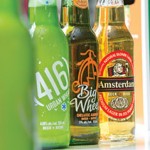
Decorated with eye-catching graphics designed by Toronto artist Tony Enns, the upscale packaging of Amsterdam Brewing’s bottled and canned products is helping fuel double-digit sales growth for the popular Toronto microbrewer.
Dutch Treat
“The original owner was a Dutch gentleman by the name of Roel Bramer who wanted to bring authentic European flavors to Toronto, so in 1986 he opened up a brew-pub on John Street in Toronto’s downtown core, which he named The Amsterdam Brasserie after the city of his birth,” relates Mistry, holder of a professional degree in Brewing & Distilling Science from the Heriot-Watt University in Scotland.
“This was at a time when imported beers were a rare sign in Ontario, well before all the Stellas and the Heinekens of the world were sold here,” Mistry points out.
“That has all changed now, of course, but the main focus for us has remained what it was back then— trying to introduce newer beers styles and brands that are still not as well-known here as they might be: Belgian wheat beers, imperial stouts, bock beers and the IPA (India Pale Ale), which is just about the hottest thing in the market right now.
“We always try to stay ahead of the curve,” Mistry told Canadian Packaging on a recent visit to the company’s current premises at the foot of Bathurst Street near the city’s historical Fort York site of former military fortifications, which the microbrewer will be vacating at the end of this year for a modern, 26,000-square-foot production facility in central Toronto to start an exciting new chapter of further volume growth and product innovation.
But the new home is hardly on top of minds at this time of the year for the 35 full-time workers brewing, packaging and delivering its premium suds to a steadily growing range of upscale restaurants, bars, pubs and LCBO (Liquor Control Board of Ontario) retail outlets across a geographic region now stretching from Ottawa in the east to London west of Toronto.
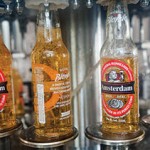
Bottles of the flagship Amsterdam Natural Blonde Lager filled at the Amsterdam Brewing Co. in Toronto.
With the hot summer months traditionally being the busiest part of the season for Canadian beermakers, the main priority is naturally to keep the beer flowing to its customers in sufficient quantities to ring in maximum sales, which have been growing at double-digit rates in recent years, according to the marketing and media director Blake Van Delft.
“We are now growing by 15 per cent every year, and the craft industry is generally growing at that pace, which is remarkable considering that beer sales as a whole are down from years before,” Van Delft says. “So obviously, people want something different than just the North American lagers these days: they want to experience the new flavors that are truly unique.
“There are some great beer styles out there that Ontarians don’t know about, so we see it as our role to introduce them to these flavors by making them as authentically as we can,” he states.
Time Change
Adds Mistry: “It’s like with wine 20 years ago: you’d go to an LCBO store and all you could get was a few table wines, but now you look at the wine section that is so inundated with variety, with so many countries and styles to choose from, that sometimes you feel like you don’t really know what to buy.
“You see the same thing happening in the beer sections, where LCBO has done a good job with giving consumers choice, especially with pushing seasonal varieties like pumpkin beer in the fall, Christmas-style beers in the winter, bock beers in the spring, IPA and wheat beers in the summer.
“They (LCBO) are doing a really good job of staying ahead of the curve themselves, and they are demanding that the brewers respond in kind,” Mistry explains.
“If you want to be part of their business, you have to be selling them something other than lager: they already have thousands of lagers; they don’t need any more.
“This really helps keep the brewers on their toes at all times,” he states.
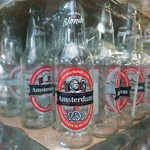
Amsterdam Brewing uses custom-made glass bottles supplied by United Glass that are permanently decorated by Serigraphie Richford via an applied ceramic labeling process to enhance brand image and provide classy aesthetic elegance for the premium beers.
With current annual production capacity of 24,000 hectoliters, a rough equivalent of 300,000 cases of 24 bottles, Amsterdam Brewing currently ranks as one of the top four biggest microbreweries out of the more than 30 craft brewers operating in Ontario, according to Mistry, with only the Mill St. Brewery and Steam Whistle Brewing of Toronto, along with the Waterloo-based Brick Brewing Co., boasting bigger capacity.
But production output alone does not tell the full story of market success in the case of a company making its living by selling premium-priced beers.
“A six-pack of our flagship Amsterdam Natural Blonde costs $12.75 at the LCBO, while you can get a six-pack of Coors Light, for example, for just over 10 bucks,” acknowledges Van Delft, “but our products are marketed to people who are looking for high-quality beer and have the disposable income to afford paying the price premium.
“These people would typically be university or college graduates: better-educated, higher-income earners looking for the “Next Flavor” beer and higher-quality, better-tasting products.
“And we offer that to them with 10 different options, from lager to IPA beers, that are made according to authentic recipes, in smaller batches to maintain better quality control, using the right yeast, better-quality hops and other ingredients, usually locally-sourced … there is no cutting corners anywhere in the process,” Van Delft asserts.
“Ultimately, it is the high quality and authenticity of our products that has enabled us to grow by 15 per cent a year—the ability to create unique taste profiles that you just can’t get from the mass-produced beers brands packed in huge quantities on super-fast filling lines.”
Some of these unique Old World taste profiles are impeccably represented by the company’s six core year-round brands, including:
•
The company’s original flagship additive-free Amsterdam Natural Blonde Lager, which is still its bestselling product both on tap and in bottles and cans, according to Van Delft.
•
The (416) Urban Wheat brand of all-natural, unpasteurized, unfiltered wheat beer with a distinct citrus aroma that makes it a popular summer-time favorite, according to Mistry, with its (416) prefix a playful homage to the city of Toronto’s original telephone area code, as well as the beer’s 4.16-percent alcohol content.
•
The all-natural, cold-filtered Big Wheel Deluxe premium amber beer brand.
•
British-style Amsterdam Nut Brown Ale—a medium-bodied dark beer made from a blend of Canadian, English and four different continental European hops to create chestnut-brown color and a rich tan head.
•
The Oranje Weiss brand of faithfully-replicated Belgian-style wheat beer.
•
The Framboise brand of fruit-flavored beer that captured a Bronze Medal at last-year’s biennial World Beer Cup competition in San Diego, Ca., in the Fruit Beer category.
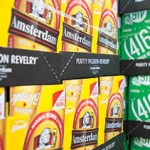
Ready-made pallets of six-packs nestled in corrugated trays, supplied by Norampac, await their turn to be shipped out for quick delivery via the company’s own mini-fleet of two trucks and three delivery vans.
“Considering there were over 4,000 entries from 75 countries in the competition, with more than 40 entries in the Fruit Beer category, this was definitely a very nice validation of what we do here at Amsterdam Brewing,” Mistry reflects.
“Brewers have been brewing this type of beer in Europe for over 400 years, so for us to win a medal in this category is a pretty big thing that really demonstrates the level of quality of our products,” he states.
Van Delft says he has high expectations for the company’s newly-launched, higher-alcohol-content (7.1 per cent by volume) Amsterdam Boneshaker IPA this coming summer season, having just recently gotten the band onto LCBO store-shelves following a year-long product development project.
“I think that Boneshaker will become one of our core beer brands,” he asserts. “This is a darker, higher-alcohol, unfiltered beer style that is really ready to take off in this marketplace.
“It is already a big seller on the U.S. West Coast, and it is quickly becoming a new favorite for a lot of people here.
“We just started brewing it last summer for tap sales in kegs, and based on the feedback we have so far, we think the retail product should do well for us this summer; it looks very promising” Van Delft says.
“It’s a little too early to get the exact sales numbers from LCBO at the moment, but it’s looking very promising.”
If so, it will make it an especially busy and exciting summer season for Amsterdam Brewery, which revs up its normal nine-hours, five-days-a-week production schedule at the Bathurst Street building—a former distribution facility for national retail chain Loblaws—to 14-hour days to keep up with the summer surge in demand, as well as to accommodate a steady phase-in of canned products into the company’s product portfolio.
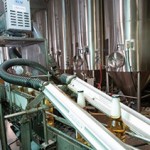
Freshly-filled bottles of beer whisked towards the Admark air-knife drying system.
“We only started doing cans about three years ago, but the marketplace feedback has been encouraging enough so that we now offer four of our core brands in cans as well as bottles,” says Van Delft, citing brisk sales for the company’s four-can Entertainer party-mix boxes featuring a can each of the Natural Blonde, Nut Brown Ale, Big Wheel and the KLB Raspberry Wheat beer brand, inherited in the course of its 2003 acquisition of the Peterborough, Ont.-based KLB (Kawartha Lakes Brewing) Co.
“Mix-packs are a good way to try different beer types, which is also becoming an industry trend,” Van Delft notes. “There are fewer people coming into stores to buy multiples of Budweisers; what you see more nowadays are people buying a single bock beer, a single IPA, and a single of something else—all the big action is in single sales now.”
While keg sales still account for about 60 per cent of the brewer’s revenues, Van Delft says the company has been very pleased with the brisk rise in sales of its bottled product, which features distinctive container shape and colors—accentuated to maximum effect by the ACL (applied ceramic labeling) process used to mark the individual bottles, supplied by Que.-based glass broker United Glass, with paperless permanent labels to achieve a classy, elegant look befitting the premium-priced product.
Paper Cut
“We used to use paper labels for all our bottles until we redesigned our bottles three years ago,” Van Delft relates. “There’s no question that the painted label does a much better job of reflecting the high quality of the beer inside the product.
“We are one of very few beer companies to be using this labeling process right now,” says Van Delft, complimenting the high-quality ACL process execution performed by glass-decorating experts at Serigraphie Richfrord Inc. for bringing the bottles to life—both the industry nonstandard 355-ml bottles used for its year-round product, including green and clear containers, and the large 500-ml bottles used to package its seasonal varieties.
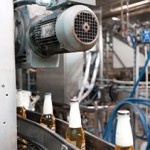
Bottls travel along a Sidel GEBO conveying system powered by heavy-duty SEW-Eurodrive motors.
“The upscale packaging definitely helps us to differentiate ourselves from the big brewers, with the eye-catching and somewhat left-of-center graphics” designed by a Toronto-based freelance designer Tony Enns, who also does graphic design work for all of the brewers’ aluminum cans and beer-boxes.
“There is also the environmental angle to this: it is more environmentally-friendly to be washing the bottles without labels, and all the waste that is generated from that process,” Van Delft reasons.
“It’s a little more of an investment cost upfront, but if you get decent recycling rates on the bottle’s reuse, then you can recoup that.”
Adds Mistry: “From manufacturing standpoint, the bottle doesn’t have to go through a label, so there are no issues with missing labels, crooked labels, rework, the use of resins and labelstock, or washing.
“The special ceramic paint is basically an enamel that gets permanently baked onto the glass in an oven for life, so that it never comes off during the wash and can be reused for as long as the bottle remains in usable shape.”
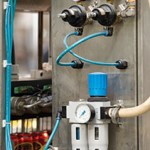
The Amsterdam Brewing conveyor lines are outfitted with a broad range of Festo pneumatic automation devices to ensure smooth-running line operation.
Adds Van Delft: “There is definitely real value in having our beer bottles labeled with ceramic paint in terms of enhancing the image of our brewery.
“It increases the chances of having consumers catching the eye-catching graphic with the corner of an eye, giving it a second look, and hopefully giving it a try.
“Having high-quality packaging is a natural complement to producing high-quality beer and growing our product range.”
Already approaching about 70 different SKUs (stock-keeping units), the brewer’s well-established product line is bound to experience further growth and refinement at its next facility, according to Mistry, who also doubles as the de facto plant manager at Amsterdam Brewing.
“We have very good staff here: everybody’s pretty laid-back and everyone gets along, it’s like an extended family really,” he says. “I also encourage everyone to get cross-trained so that our people are interchangeable and the operation doesn’t skip a beat because of one person missing.
“I couldn’t ask for a better bunch of people to work with, and I’m really looking forward to starting up a new chapter at our new facility next year.”









